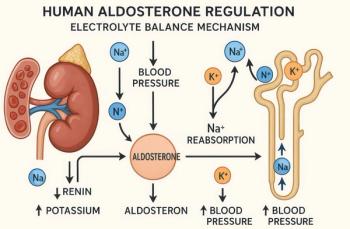
The “Statin-Intolerant” Patient: Alternative Strategies for Primary Care
In patients deemed statin-intolerant, lifestyle changes and alternative classes of drugs should be pursued to lower LDL-C.
Statins are highly effective for lowering low-density lipoprotein cholesterol (LDL-C) levels, which results in lower mortality and fewer major adverse cardiovascular events.1,2 This class of medications works by competitively inhibiting HMG-CoA (3-hydroxy-3-methylglutaryl-CoA) reductase activity, thereby decreasing cholesterol synthesis in the liver. For every 1 mmol/L (approximately 40 mg/dL) reduction in LDL-C, there is a 22% reduction in major vascular events and a 10% decrease in all-cause death.3 It is believed that the major benefit comes from the lowering of the LDL-C level, but additional pleiotropic effects of statins may also contribute to the benefit. Therefore, in patients who are deemed “statin-intolerant,” lifestyle changes and alternative classes of drugs should be pursued to achieve LDL-C target levels and minimize risk.
Here we present the mechanisms of statin intolerance and offer alternative options for treating patients with difficult-to-manage hypercholesterolemia.
Statin intolerance
The mechanism of statins (HMG-CoA reductase inhibition) leads to an interruption of the cholesterol biosynthetic pathway, which also results in shunting away from the generation of antioxidants such as ubiquinone (also known as coenzyme Q10 [CoQ10]). The depletion of these antioxidants has been hypothesized to result in adverse effects-particularly in metabolically active tissues, such as skeletal muscle. Evidence has shown that supplementation can increase CoQ10 levels, but it is not clear from current small studies whether that reduces myopathic symptoms.4 However, because there are few adverse effects from CoQ10 supplements, they can be tried in patients with myalgia who require LDL-C–lowering treatment and in those in whom statin myalgia develops. Some of these patients may respond to supplemental CoQ10; in others, there may be a placebo effect.
In patients who take statins, adverse effects can manifest as myalgias, muscle weakness, myopathy and, rarely, rhabdomyolysis. A meta-analysis of 18 trials included 71,108 persons, of whom 36,062 received statins and 35,046 received a placebo.5 The number needed to treat (NNT) with statins to reduce the risk of a clinical cardiovascular event was only 27 patients; for any adverse reaction, the number needed to harm (NNH) was 197. Serious adverse reactions, such as creatine phosphokinase levels greater than 10 times the upper limit of normal (NNH = 3400) and rhabdomyolysis (NNH = 7428), are rare. Risk factors for the development of statin adverse effects are female sex, older age, a low body weight, presence of renal or liver disease, and alcohol use.6
The risk of serious adverse effects is relatively low, and statins are generally very well tolerated. Myalgias, however, can occur frequently (in 5% to 10% of those receiving statin therapy) and are one of the key adverse effects that limit adherence to a statin regimen. Liver function abnormalities (usually reversible asymptomatic elevations in transaminase levels) can also occur and may prompt discontinuation of therapy. Routine monitoring with liver function tests is no longer recommended in statin-treated patients. Nonetheless, in a significant number of patients, abnormalities in these tests result in drug discontinuation. In addition, a relationship has been discovered between glucose homeostasis and cholesterol synthesis, providing a mechanistic explanation for the slightly increased risk of diabetes mellitus observed in patients taking statins. Because of this, many patients can be deemed statin-intolerant. One estimate reports that only about half of the 71 million patients with hyperlipidemia in the United States are actually treated with lipid-lowering therapy.7
Diagnostic approach to a patient with possible statin intolerance
Many patients report muscle aches or weakness while taking statins. Whether or not the symptoms are associated with the statin or a comorbid condition (eg, arthritis) is not always clear. Thus, before permanent discontinuation of the statin because of myalgias, attempt to firm up the diagnosis using a “drug holiday” from the statin followed by “re-challenge” with the medication several weeks later, after resolution of symptoms. If symptoms do not recur, then it would appear that they are not actually related to the statin, and resumption of the statin is possible.
Alternative treatment strategies for the statin-intolerant patient
There are many effective nonpharmacologic and pharmacologic strategies for managing the adverse effects of statins. Some include titrating the statin dose, while others recommend using alternative agents.
• Adjusting the statin regimen. Since statin-related adverse effects are dose-related, reducing the dose is a first approach; switching between statin classes is another option. There are standard and intensive statin regimens, and although there is greater benefit with intensive statin therapy,8 titrating the dose down may ameliorate adverse effects. Alternatively, the medication can be taken every other day or 3 times a week to try to make the adverse effects more manageable.
• Checking for drug-drug interactions. Since some drug-drug interactions can increase the blood statin level and, hence, increase the risk of myopathy, it is important to look at other medications the patient is taking. For example, amiodarone can increase statin levels, such that for simvastatin, the maximum recommended dose is 20 mg.
• Lifestyle changes. When a patient experiences statin intolerance, it becomes even more important to impress on him or her, the established benefit of exercise and diet. A heart-healthy diet that includes phytosterols; weight loss; regular aerobic exercise; and a well-balanced, calorie-controlled diet are essential for lowering LDL-C levels and cardiovascular risk. These interventions can result in a 10% to 15% lowering of the LDL-C level.
• Established pharmacologic options. Non-statin LDL-C–lowering drugs can be used when cholesterol targets cannot be reached with statins or lifestyle changes. Although not nearly as effective as statins, these therapies can lower LDL-C levels up to 30% when used in combination:
-- Ezetimibe, which impairs cholesterol absorption from the intestine, can lower LDL-C levels by 15% to 22% and can be used alone or in addition to drugs in other classes.
-- Fibrates interfere with lipid and lipoprotein metabolism and lower LDL-C levels by 10% to 20%. Niacin, which may cause flushing, decreases fatty acid influx to hepatocytes and the secretion of very-low-density lipoprotein by the liver and lowers the LDL-C level by 15% to 18%.
-- Bile acid sequestrants, which increase bile synthesis and secretion of cholesterol from the liver, may result in GI adverse effects. However, these agents are effective and can lower LDL-C levels by 18% to 25%.
These drugs can be used alone, or they can be administered together if tolerated. Common combination regimens are ezetimibe and niacin; ezetimibe and bile acid sequestrants; and ezetimibe, bile acid sequestrants, and niacin.
• Investigational pharmacologic options. Drugs with actions at various steps of the cholesterol metabolic pathway, from synthesis to circulation to recycling and uptake, are now in clinical trials.
Among these medications, the most promising are those that target reverse cholesterol transport (the cholesteryl ester transfer protein inhibitors, dalcetrapib, anacetrapib, and evacetrapib) and those that inhibit LDL-C receptor degradation (via inhibition of PCSK9). The phase 2 study of the PCSK9 inhibitor AMG145 in statin-intolerant patients is ongoing, and results are expected in late 2012. In addition, the use of inhibitors of apolipoprotein synthesis (such as mipomersen) have demonstrated a dramatic 47% reduction in LDL-C levels, with a concurrent reduction in apolipoprotein B and triglyceride levels and a small increase in high-density lipoprotein cholesterol levels.9
Practice message
The need to find alternative treatments for the statin-intolerant patient cannot be emphasized enough. Lowering LDL-C levels controls cardiovascular risk factors; therefore, treatment for patients with hyperlipidemia is critical. In addition to lifestyle changes, there are a number of alternative treatment strategies that can be used alone or in combination to lower LDL-C levels while providing an adverse-effect profile that is acceptable to the patient and will maximize adherence. There are several LDL-C–lowering agents in clinical trials that may ultimately provide a perfect solution to treating patients who are statin-intolerant. With the use of alternative strategies and diligence on the part of the physician, all patients with hyperlipidemia should be able to lower their LDL-C levels effectively.
References
1. O’Keefe JH Jr, Cordain L, Harris WH, et al. Optimal low-density lipoprotein is 50 to 70 mg/dl: lower is better and physiologically normal. J Am Coll Cardiol. 2004;43:2142-2146.
2. Ballantyne CM. Low-density lipoproteins and risk for coronary artery disease. Am J Cardiol. 1998;82:3Q-12Q.
3. Cholesterol Treatment Trialists’ (CTT) Collaboration, Baigent C, Blackwell L, Emberson J, et al. Efficacy and safety of more intensive lowering of LDL cholesterol: a meta-analysis of data from 170,000 participants in 26 randomised trials. Lancet. 2010;376:1670-1681.
4. Marcoff L, Thompson PD. The role of coenzyme Q10 in statin-associated myopathy: a systematic review. J Am Coll Cardiol. 2007;49:2231-2237.
5. Silva MA, Swanson AC, Gandhi PJ, Tataronis GR. Statin-related adverse events: a meta-analysis. Clin Ther. 2006;28:26-35.
6. European Association for Cardiovascular Prevention & Rehabilitation, Reiner Z, Catapano AL, De Backer G, et al; ESC Committee for Practice Guidelines (CPG) 2008-2010 and 2010-2012Committees. ESC/EAS Guidelines for the management of dyslipidaemias: the Task Force for the management of dyslipidaemias of the European Society of Cardiology (ESC) and the European Atherosclerosis Society (EAS). Eur Heart J. 2011;32:1769-1818.
7. Centers for Disease Control and Prevention. Vital signs: prevalence, treatment, and control of high levels of low-density lipoprotein cholesterol-United States, 1999-2002 and 2005-2008. MMWR Morb Mortal Wkly Rep. 2011;60:109-114.
8. Cannon CP, Braunwald E, McCabe CH, et al. Intensive versus moderate lipid lowering with statins after acute coronary syndromes [published correction appear in N Engl J Med. 2006;354:778]. N Engl J Med. 2004;350:1495-1504.
9. Visser ME, Wagener G, Baker BF, et al. Mipomersen, an apolipoprotein B synthesis inhibitor, lowers low-density lipoprotein cholesterol in high-risk statin-intolerant patients: a randomized, double-blind, placebo-controlled trial. Eur Heart J. 2012;33:1142-1149.
Newsletter
Enhance your clinical practice with the Patient Care newsletter, offering the latest evidence-based guidelines, diagnostic insights, and treatment strategies for primary care physicians.
















































































































































































































































































